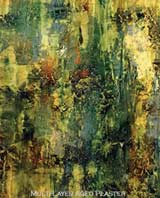
Caroline Woldenberg is one of those rare individuals who teaches, and creates, within a curious niche of the world of finishing. She runs a school and contract company for faux finishing called “The Finishing Source, Inc.”
Faux finishing is the art of making wood, or any other material, for that matter, look like something it is not. That includes faux bois (fake wood grain); faux marble; fake tortoiseshell; various stones, like malachite and lapis; a wealth of antiquing techniques; and even trompe l’oeil, a French term meaning “fool the eye.” Trompe l’oeil uses paint to create depth and shadow, simulating anything from moldings that aren’t there to artful pieces of paper taped onto a fake wood grain surface. Good trompe l’oeil will often have people reaching to touch things that simply don’t exist. These samples, in spite of how they look, are all done on flat, polystyrene panels.

The Finishing Source, Inc., is both a contracting company and a finishing school in Atlanta, Georgia, with two instructors and several other employees who work on the contracting side but also help out in customer service for the school. In addition, they distribute one manufacturer’s paint line. Faux Effects International is a maker of waterbased paints, which they also use in their work. “This field is a balance of technology, artistry and business,” Caroline explains. “You need all three elements to survive.”
Caroline’s company started out focusing on furniture finishing, but also includes decorative wall finishing as well. The two methods are quite different, largely because the materials must be manipulated to either be slow enough to work for large wall surfaces, or sped up for the multi-layer requirements of furniture finishing. The application techniques, however, are similar, and the final results are very similar. “We typically work through design firms in people’s homes,” Caroline told me. “When we go into a home, we often do the walls, trim, cabinets: everything in the house.”

Caroline originally got into the field after studying theater in college, where she often found herself painting sets. “My interests were less in acting than in creating sets and scenery. I studied business at Emory University, but enjoyed my time with the theater group more. After college, I knew I wanted to be in applied arts, so I went back and got my degree in interior design and worked as a hotel interior designer. Eventually, I took off for New York, studied there, then moved back to Atlanta to open a decorative arts business.”
The educational portion of her business is a sister school to The Finishing School, which has three other locations. “The four programs work together,” Caroline explained, “each bringing its own expertise to the mix.” The Finishing School was founded in New York by Ina and Allan Marx, along with their son, Robert, in 1981. Ina studied with the legendary Isabel O’Neil, the grand dame of American faux finishing and author of “The Art of the Painted Finish,” considered by many to be the seminal work on the subject. O’Neil ran an unusual school, the first of its type in the United States, in which wealthy matrons made extravagant ornamental plates finished in highly ornate faux techniques.
After Ina and Allan retired, Robert continued to look for new materials and techniques. Around 1991, he moved the school into waterbased materials, and that is when Caroline Woldenberg entered the scene. Caroline, who also was a former student of the late Isabel O’Neil, took some classes there. “I had been working in oils. Robert contacted three of us to consult with him about doing these oil-based techniques in waterbased materials. I spent the next few years transferring my business to waterbased and continuing to consult with Robert. A few years later, I started flying up to New York to teach at the school. Eventually, that aspect of my business became a full-time program.”

The other schools are in Delaware and Pennsylvania. Each location teaches wall finishes along with some other specialties. The Delaware school is run by a muralist who also does marbling and faux bois (wood graining); the Pennsylvania expert does gilding and other decorative techniques. Caroline’s specialty includes such art finishes as tortoiseshell, lapis lazuli, malachite, marble and other stones, but she also teaches faux bois, trompe l’oeil, and other faux styles. The advantage of the four-school relationship is that you can take any of the courses, from any of the instructors, at any of the locations. The Atlanta school specializes in furniture finishing so, for the most part, those interested in furniture finishing are drawn there.
“We generally attract professionals who are already decorative artists,” Caroline said of the school. “In the past, we didn’t get a lot of hobbyists, since the classes are rather intensive and not cheap, but that may be changing. For hobby finishers, I generally recommend starting with a distressing and aging class. Distressing and aging is a workhorse class at our school, and we consider it a core course. People take this class and translate it to moldings, architectural elements, furniture and cabinetry. This year, we added a course in creative cabinetry, for those who want something more than the mundane finishes on their kitchen and bathroom cabinets. The course is wildly popular, and we have added more sections for later this year and next year.”

“We want to be a place where people can learn the traditional decorative finishing techniques,” Caroline told me. “We have ongoing relationships with our customers so that they continue to learn. This sort of finishing is not something you can pick up in a few hours.”





